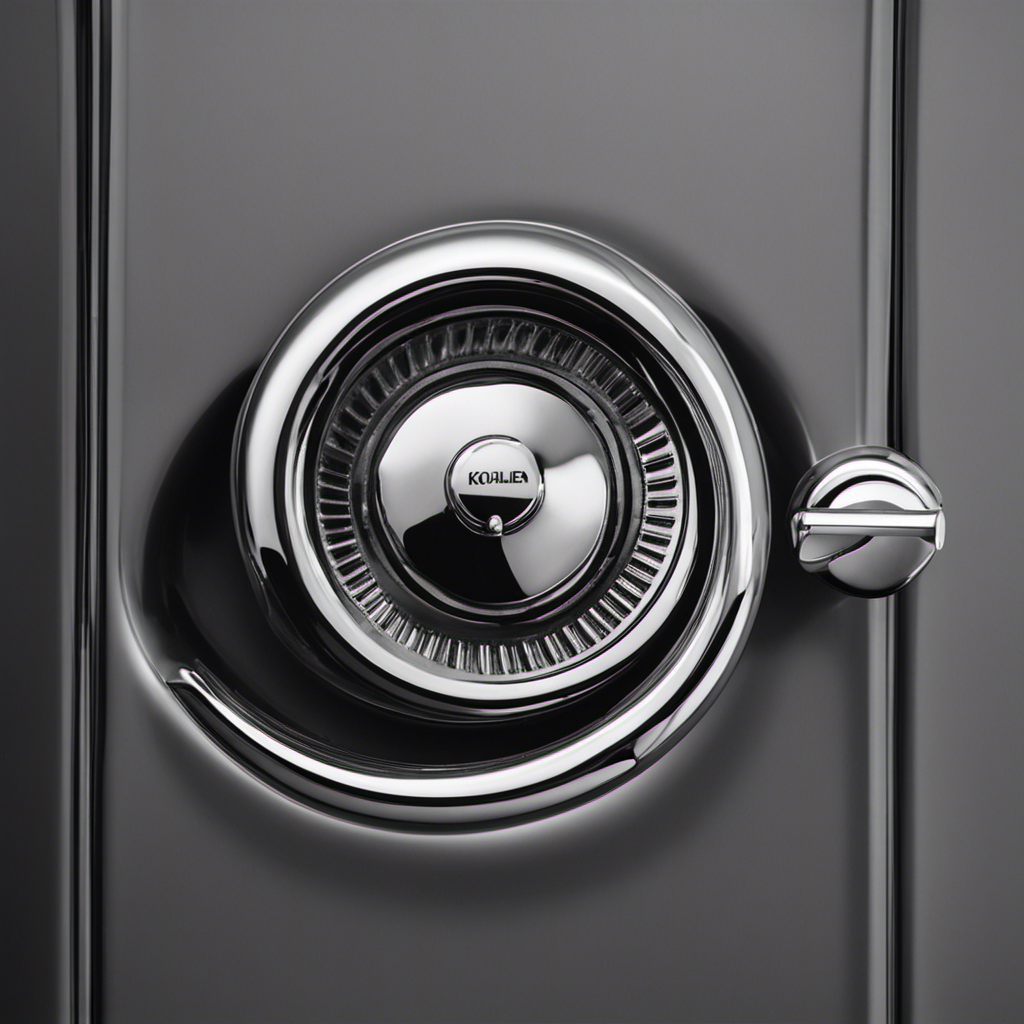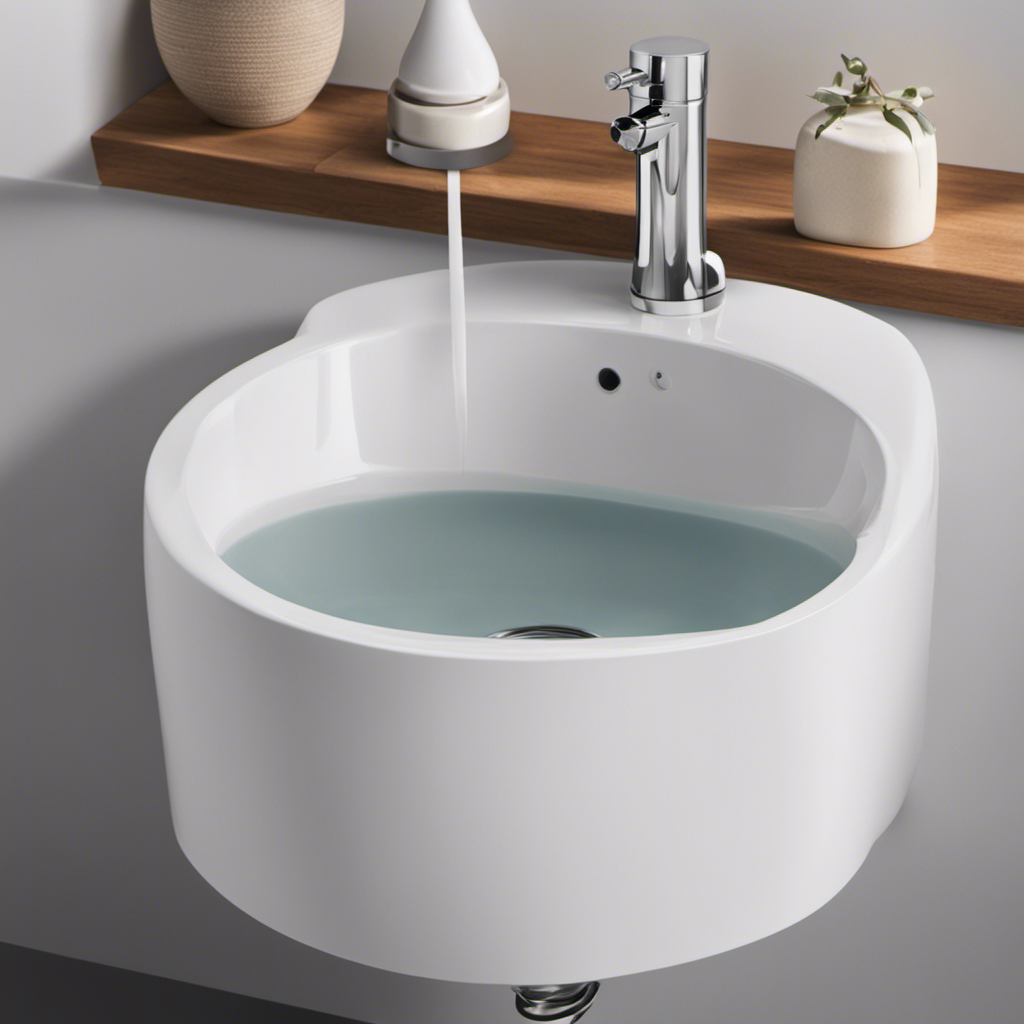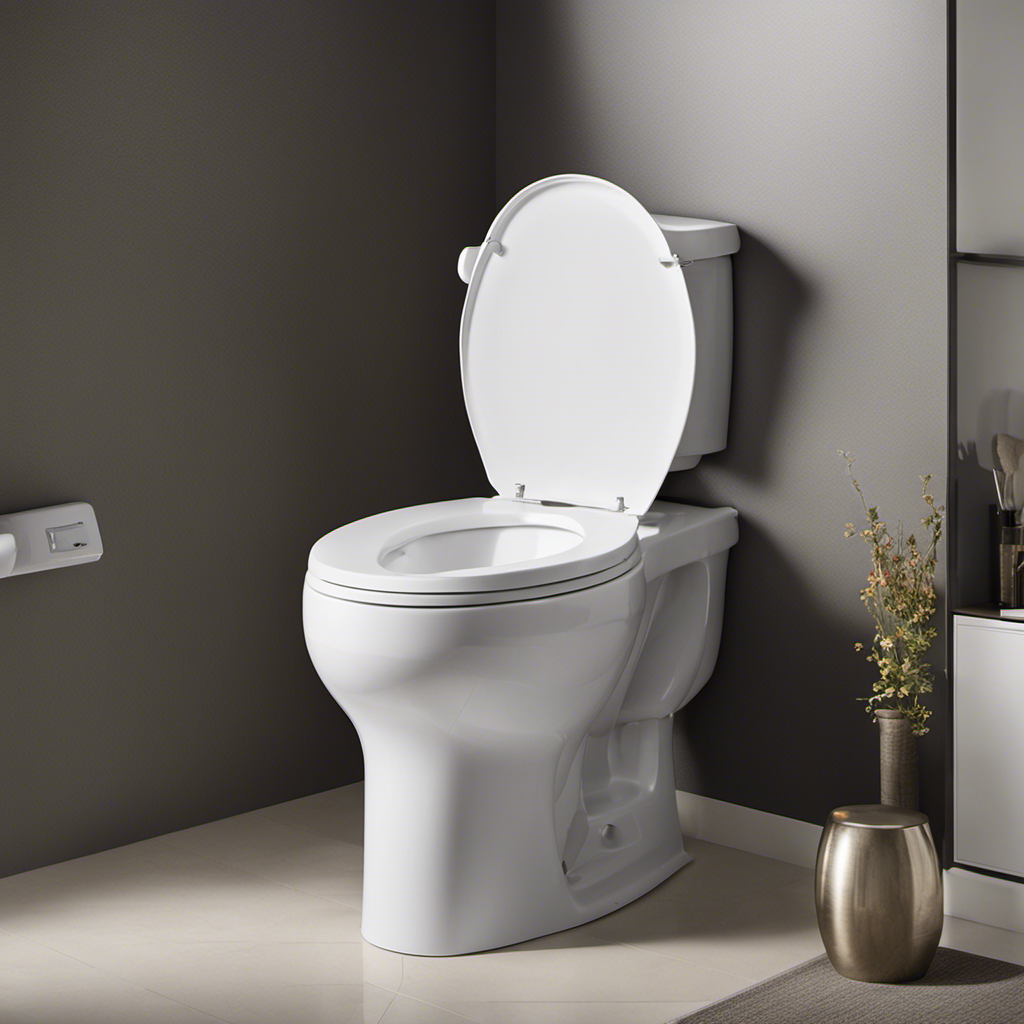I’ve got a simple solution to your water level woes in your Kohler toilet bowl.
Let me guide you through the steps of adjusting it with ease.
Understanding the components and following a step-by-step approach, I’ll show you how to maintain the perfect water level.
No more frustration or guessing games.
With my knowledgeable and detailed instructions, you’ll have a smooth-running toilet in no time.
So, let’s dive in and conquer this issue together!
Key Takeaways
- The fill valve and float are responsible for maintaining the water level in a Kohler toilet bowl.
- Adjusting the float level can help regulate the water level in the bowl.
- Troubleshooting common toilet issues and cleaning the float valve can address water level problems.
- Proper water level is crucial for efficient flushing and waste removal.
Understanding the Water Level in a Kohler Toilet Bowl
To understand the water level in your Kohler toilet bowl, you’ll need to know how the fill valve and float work together.
The fill valve is responsible for refilling the tank after each flush, while the float is a small device that rises and falls with the water level.
When the tank is empty, the fill valve opens and water begins to flow into the tank. As the water level rises, the float also rises. Once the water reaches a certain level, the float signals the fill valve to close, stopping the flow of water.
If you’re experiencing issues with the water level in your Kohler toilet bowl, there are some troubleshooting tips and maintenance techniques you can try.
Identifying the Different Components of a Kohler Toilet Bowl
The various parts of a Kohler toilet can be easily identified. One of the most important components is the toilet bowl itself, which is the main receptacle for waste. It is usually made of porcelain and has a water trap that prevents odors from escaping. Another crucial component is the flush valve, which is responsible for releasing water from the tank into the bowl to initiate the flushing process. Lastly, there is the fill valve, which is responsible for refilling the tank with water after each flush.
To make it easier to understand, here is a table that provides a visual representation of the different components and their functions:
| Component | Function |
|---|---|
| Toilet Bowl | Receptacle for waste |
| Flush Valve | Releases water for flushing |
| Fill Valve | Refills tank with water after flush |
Step-by-Step Guide to Adjusting the Water Level in a Kohler Toilet Bowl
When it comes to troubleshooting water level issues in a toilet, there are a few key points to keep in mind.
Firstly, it is important to properly adjust the float in order to maintain the desired water level. This can be done by either adjusting the float arm or the float ball itself.
Additionally, being aware of common toilet issues such as a constantly running toilet or a toilet that won’t flush properly can help identify the root cause of the water level problem and guide the troubleshooting process.
Water Level Troubleshooting
You can troubleshoot the water level in your toilet bowl by checking the float valve. The float valve is responsible for regulating the amount of water that enters the tank. If the water level is too low, you may experience weak flushes or incomplete waste removal. On the other hand, if the water level is too high, it can cause constant running and waste water.
To troubleshoot the water level, follow these steps:
-
Check the float valve: Ensure that the float valve is not stuck in the closed position. If it is, gently lift it to see if the water level adjusts accordingly.
-
Adjust the float level: If the float valve is working properly, you may need to adjust the float level. This can be done by either bending the float arm slightly downward to lower the water level or bending it upward to increase the water level.
-
Clean the float valve: Sometimes, debris can get stuck in the float valve, preventing it from functioning properly. Remove any dirt or buildup and ensure that the valve moves freely.
Proper Float Adjustment
To properly adjust the float, gently bend it either downward or upward to achieve the desired water level in your toilet. The float mechanism is responsible for controlling the water level in the toilet bowl, and it plays a crucial role in maintaining the proper functioning of your toilet.
When the water level is too high, it can lead to constant running or even overflowing. On the other hand, if the water level is too low, it may not flush properly. By adjusting the float, you can ensure that the water level is at the optimal height for efficient flushing and prevent any potential issues.
Now, let’s move on to some common toilet issues that you may encounter.
Common Toilet Issues
Now that we’ve discussed proper float adjustment, let’s move on to some common toilet issues that can affect the water level in the bowl.
Water level problems can be quite frustrating, as they can lead to poor flushing and even clogs. One common issue is a clogged or partially blocked toilet trap. This can prevent water from flowing properly into the bowl, causing the water level to be lower than normal.
Another problem could be a faulty fill valve, which controls the water level in the tank. If the fill valve is not functioning properly, it may not allow enough water to enter the bowl, resulting in a low water level.
To maintain the toilet bowl and prevent these issues, regular cleaning and maintenance is essential. This includes using a toilet brush and cleaner to remove any buildup or debris that could obstruct the water flow.
Common Issues and Troubleshooting Tips for Water Level Adjustment in a Kohler Toilet Bowl
When it comes to adjusting the water level in a Kohler toilet bowl, there are a few key points to keep in mind.
First, low water level can be a common issue that can lead to poor flushing and incomplete waste removal.
On the other hand, a high water level can cause water to overflow and potentially damage the bathroom floor.
Thankfully, adjusting the water level in a Kohler toilet bowl is a relatively simple process that can be done using the fill valve adjustment screw.
Low Water Level
You can easily increase the water level in your Kohler toilet bowl by adjusting the fill valve. Here are some troubleshooting tips for water level maintenance:
-
Check the water supply: Ensure that the water supply valve is fully open to allow sufficient water flow into the toilet tank.
-
Adjust the fill valve: Locate the fill valve, typically located on the left side of the toilet tank. Turn the adjustment screw clockwise to increase the water level.
-
Check the flapper: A faulty flapper can cause low water levels. Inspect the flapper for any damage or debris and replace if necessary.
-
Clean the toilet tank: Sediment and mineral buildup can affect the water level. Regularly clean the toilet tank to prevent clogs and maintain proper water flow.
High Water Level
To decrease the high water level in your toilet tank, try cleaning the flush valve to remove any debris or mineral buildup. This is a common issue that can cause the water level to rise above the normal range. Cleaning the flush valve is a simple and effective way to address this problem. Here are some troubleshooting tips for maintaining the water level in your toilet:
| Problem | Possible Solution |
|---|---|
| High water level | Clean the flush valve to remove debris and mineral buildup |
| Low water level | Adjust the fill valve to increase the water level |
| Fluctuating water level | Check for leaks and adjust the float valve if necessary |
| Overflowing toilet | Replace the fill valve or adjust the float valve to prevent overflow |
Adjusting Water Level
When dealing with a high water level in a Kohler toilet bowl, it is important to understand how to adjust the water level to maintain proper functionality. One way to do this is by adjusting the float mechanism, which controls the water level in the tank. Here are some key steps to follow:
- Locate the float mechanism, usually a ball or cup attached to a metal arm.
- Adjust the water level by bending the metal arm or adjusting the screw on the float mechanism.
- Test the water level by flushing the toilet and observing the refill process.
- Repeat the adjustment process if necessary until the desired water level is achieved.
By following these steps, you can effectively control the water level in your Kohler toilet bowl, ensuring optimal performance and preventing any issues related to high water levels.
Now let’s move on to some tips for maintaining the proper water level in a Kohler toilet bowl.
Tips for Maintaining the Proper Water Level in a Kohler Toilet Bowl
One way to ensure the proper water level in your Kohler toilet bowl is by adjusting the fill valve. Proper water level is crucial for the toilet to function efficiently and prevent any issues. To maintain the water level, you can follow these troubleshooting tips:
| Troubleshooting Tips | Description |
|---|---|
| Check the float | Ensure the float is not stuck or damaged. Adjust or replace if necessary. |
| Inspect the fill valve | Check for any clogs or debris that may be affecting the water flow. Clean or replace if needed. |
| Adjust the water level | Use the adjustment screw on the fill valve to increase or decrease the water level in the toilet bowl. |
| Test the flush | After making adjustments, flush the toilet to ensure the water level is maintained properly. |
| Seek professional help | If troubleshooting doesn’t resolve the issue, it’s best to consult a professional plumber for further assistance. |
Additional Considerations and Best Practices for Water Level Adjustment in a Kohler Toilet Bowl
Another important factor to consider when adjusting the water level in a Kohler toilet is the float mechanism. This mechanism is responsible for controlling the water flow into the tank and ultimately, the bowl.
To ensure the best performance and prevent any issues, here are some best practices and troubleshooting tips to keep in mind:
-
Check the float arm: Make sure it is properly attached and not bent or damaged. Adjust the position if needed to ensure the correct water level.
-
Clean the float: Over time, debris and mineral deposits can build up on the float, affecting its performance. Regularly clean it to maintain optimal operation.
-
Inspect the fill valve: Ensure that the fill valve is working properly and not leaking. Replace it if necessary to prevent water wastage.
-
Test the water level: After making adjustments, flush the toilet and observe the water level. It should be around 1 inch below the overflow tube.
Frequently Asked Questions
Can I Adjust the Water Level in a Kohler Toilet Bowl if I Don’t Have Any Previous Plumbing Experience?
Yes, you can easily adjust the water level in a Kohler toilet bowl even if you have no plumbing experience. It’s a simple troubleshooting task that can be done using the water level adjustment screw.
Is It Possible to Adjust the Water Level in a Kohler Toilet Bowl Without Using Any Tools?
Yes, you can adjust the water level in a Kohler toilet bowl without using any tools. Troubleshooting water level issues is relatively simple and can be done by adjusting the float or fill valve.
Can Adjusting the Water Level in a Kohler Toilet Bowl Cause Any Damage to the Toilet or Plumbing System?
Can adjusting the water level in a Kohler toilet bowl cause any damage to the toilet or plumbing system? It’s crucial to understand the potential consequences before making any adjustments to ensure the longevity of your fixtures.
How Often Should I Check and Adjust the Water Level in a Kohler Toilet Bowl?
I check and adjust the water level in my Kohler toilet bowl regularly to ensure it’s at the correct level. Troubleshooting low water levels and maintaining the right level are important for proper functioning.
Are There Any Specific Safety Precautions I Should Take When Adjusting the Water Level in a Kohler Toilet Bowl?
When adjusting the water level in a Kohler toilet bowl, it is important to take specific safety precautions. Common mistakes include not turning off the water supply and not following the manufacturer’s instructions.
Conclusion
In conclusion, adjusting the water level in a Kohler toilet bowl is a simple yet crucial task that every homeowner should know. By understanding the different components and following the step-by-step guide provided, you can easily maintain the proper water level and avoid any potential issues.
Remember to troubleshoot common problems and regularly maintain your toilet bowl to ensure its optimal performance.
So, don’t wait any longer – take charge of your toilet’s water level and experience a worry-free flushing experience like never before!










